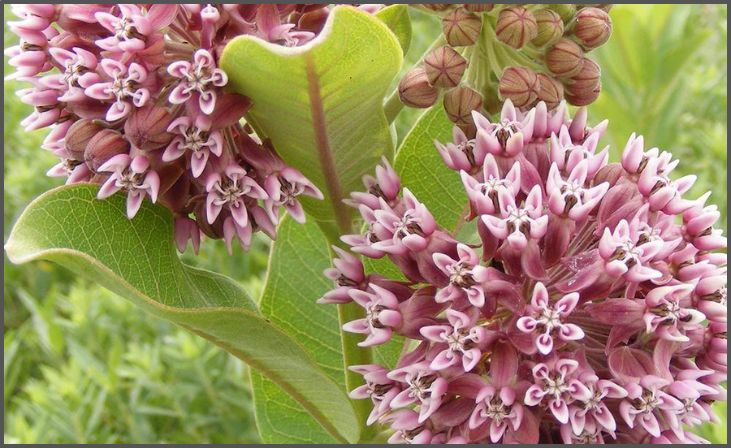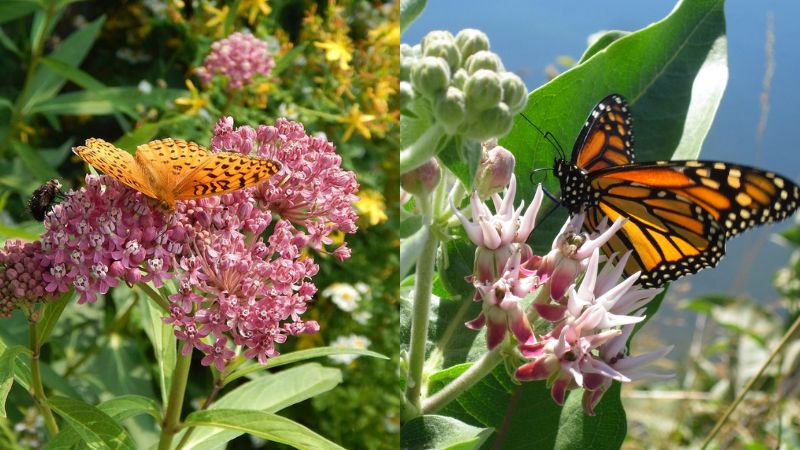In the delicate dance of nature, few spectacles rival the graceful flutter of monarch butterflies. Their annual migration, spanning thousands of miles, is a testament to both resilience and fragility. Central to their existence is the milkweed plant, the primary source of sustenance for monarch caterpillars. As stewards of the environment, we can play a pivotal role in supporting these majestic creatures by cultivating various types of milkweed in our gardens. Join us as we explore the top eight types of milkweed to foster a thriving habitat for monarch butterflies.
Common Milkweed (Asclepias syriaca):

As its name suggests, common milkweed is a widespread variety found across North America. Its robust stems and broad leaves provide ample nourishment for monarch caterpillars. Come summer, clusters of fragrant pink flowers adorn its stalks, attracting not only monarchs but also a myriad of other pollinators.
Swamp Milkweed (Asclepias incarnata):
Thriving in moist soils, swamp milkweed is a favorite among gardeners seeking to attract monarch butterflies. Its vibrant pink blooms add a splash of color to wetland habitats, beckoning monarchs to lay their eggs. Despite its affinity for damp conditions, swamp milkweed adapts well to garden settings with adequate moisture.
Butterfly Weed (Asclepias tuberosa):
A cherished species among pollinator enthusiasts, butterfly weed captivates with its brilliant orange flowers. Unlike other milkweeds, it prefers well-drained soils and thrives in sunny locations. Its nectar-rich blossoms serve as a vital fueling station for adult monarchs embarking on their arduous journey.
Showy Milkweed (Asclepias speciosa):
True to its name, showy milkweed commands attention with its striking appearance. Sporting large, elliptical leaves and spherical clusters of pinkish-white flowers, it adds a touch of elegance to any landscape. Monarch caterpillars readily feast on its foliage, making it an indispensable host plant in butterfly gardens.
Mexican Whorled Milkweed (Asclepias fascicularis):
Native to the western United States, Mexican whorled milkweed offers a western counterpart to its eastern relatives. Its slender stems and narrow leaves form a distinctive whorled pattern, earning it a place of honor in xeriscape gardens. Despite its drought tolerance, it provides essential sustenance for monarch caterpillars.
Purple Milkweed (Asclepias purpurascens):
For those seeking a splash of color in their gardens, purple milkweed presents an irresistible option. Endemic to the eastern United States, its delicate purple blooms stand out against a backdrop of green foliage. Although less common than other species, it plays a vital role in supporting monarch populations.
White Milkweed (Asclepias variegata):
Elegant and understated, white milkweed adds a touch of sophistication to native plantings. Its slender stems bear clusters of white flowers tinged with pink, creating a soft, ethereal beauty. While less showy than its counterparts, it serves as a crucial food source for monarch caterpillars.
Whorled Milkweed (Asclepias verticillata):

Compact yet charming, whorled milkweed embodies simplicity and grace. Its slender stems produce clusters of small, star-shaped flowers, reminiscent of delicate lace. Despite its diminutive stature, it packs a punch in terms of ecological value, providing sustenance for monarchs in various habitats.
Conclusion:
In the intricate tapestry of life, every thread plays a vital role in sustaining the delicate balance of ecosystems. By cultivating diverse types of milkweed in our gardens, we can create havens of biodiversity where monarch butterflies thrive. Let us embrace our role as caretakers of the earth and celebrate the beauty of nature in all its forms. Together, we can ensure a brighter future for monarchs and generations yet to come.


